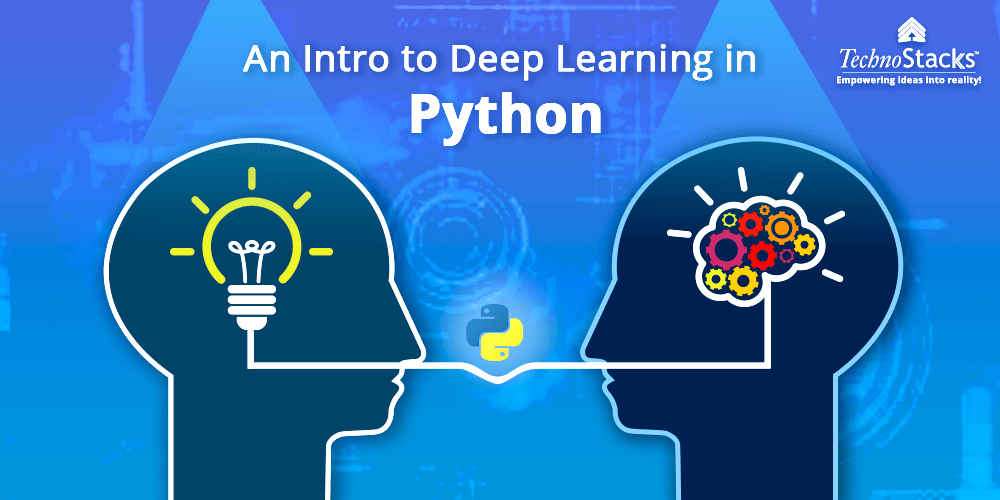A Quick & Easy Way Of Knowing Deep Learning In Python Especially For Beginners

Technostacks
Way back in the year 1991 when the great Guido van Rossum had released Python as his side assignment, he had not expected that python would become the world’s fastest developing computer language of the near future. If the trends are to be believed, Python turns out to be a go-to language for the fast prototyping.
If an individual dwells deep at the philosophy with which the Python language is created, one can say that the language had been built for the purpose of its readability and its less complex nature. One can easily understand the language as well as make someone else also understand the same very fast.
The language Python is successful at winning the hearts of its users. As per the Hackerrank 2018 developer survey, it is believed that the JavaScript might be the top most in-demand Programming language by the employers, but the Python language has won the heart of the developers across all the age groups, as per the Love-Hate index.
Why deep learning in python?
It is essential to understand that why would someone wish to use only the Python language in designing any kind of deep learning project. Deep learning in layman terms, is the usage of the data in order to help a machine make intelligent decisions.
For instance — one can build a spam detection algorithm in which the rules may be learned from a data or an anomaly of detection of the rare events by observing at the previous data or by arranging the email based on the tags that one had assigned by viewing the email history and so on. The main task of deep learning is to simply recognize the patterns in a given data set.
One of the critical tasks of a deep learning engineer in his/her career life is to extract, refine, define, clear, arrange and understand the data that is given, in order to develop a set of intelligent algorithms. Thus for a deep learning engineer or a Computer Vision Engineer or a budding Data Scientist or a deep learning or an Algorithm Engineer or a Deep learning engineer one would definitely recommend Python, as it’s easy to understand.
Many times the concepts of topics such as Linear Algebra, Calculus are so complex, that they take a significant amount of effort. A simple implementation in the Python language helps the engineer to validate an idea. There are simple python deep learning tutorials available which offer the best possible assistance to language usage.
Data is the primary factor
Thus it entirely depends on the kind of the task where one wants to use deep learning. Let us take a view at a few instances and examples. For a computer vision projects, the input data is the image or the video. For a statistical review, it may be a series of points across time or a collection of language documents that are spread across the various domains or the audio files that are given or simply some numbers.
Try to imagine that everything which exists around is in the form of data. And the data is raw, inadequate, incomplete, unstructured, and large. Python can be a guide for deep learning to tackle all of the problems.
Python has a collection as well as code stack of the various open source repositories that is developed by the people (and still in process) for the purpose of continuously improving upon the existing methods.
That are very helpful for deep learning for beginner’s category of people. The following are some of the guide for deep learning in python:
- In order to work with images — opencv, scikit and numpy
- In order to work with text — nltk, numpy, scikit
- In order to work with audio — librosa
- In order to resolve the deep learning problem — scikit, pandas
- In order to view the data clearly — seaborn, scikit, matplotlib
- In order to utilize the deep learning — pytorch, tensorflow
- In order to perform scientific computing — scipy
- In order to integrate any kind of web applications — Django
Deep learning in Python: the implementation matters
The total implementation of the clustering algorithm will open up insights towards the problem then simply reading the algorithm. In python, when a user implements the things, it is going to perform much faster in order to prototype code and then test it.
Key Takeaways
Thus it can be seen that if the focus is on the overall task that is needed to train, validate as well as test the models — so far as they satisfy the aim of a problem, any tool/language/framework may be used. Be it for the purpose of extracting the raw data from an API, or analyzing it, or performing an in-depth visualization and creating a classifier for a given task. But the primary reason for using deep learning in Python would mainly be its readability, versatility, and ease of understanding. You can cater your requirement to deep learning python experts to build an awesome application.
